The Ultimate Acadia National Park Travel Guide
This Maine destination is a place of rugged coastal wonders and an immersion in Down East culture
New perk: Easily find new routes and hidden gems, upcoming running events, and more near you. Your weekly Local Running Newsletter has everything you need to lace up! .
As of press time, some trails, campsites, and businesses are closed due to Covid-19 precautions. To check for safety protocols and potential closures, check individual websites before you go.
Unlike many national parks, a visit to Acadia can easily stand in for a visit to the state itself. The 49,076-acre site, predominantly located on Maine’s Mount Desert Island��(MDI),��is intertwined with fishing villages and tiny seasonal enclaves, and it’s not always clear where its boundaries are. Lobster boats rumble below Acadia’s cliffs as they move from buoy to buoy pulling traps. Uninhabited Bar Island, isolated from the rest of the park, is connected��to downtown Bar Harbor via a strip of gravel beach, which serves as��a natural sidewalk at low tide. The route to Bass Harbor Head Light, one of three lighthouses managed by the park, passes through neighborhoods where yards are filled with towers of lobster traps. The��Abenaki��people, who have migrated between this coast and inland Maine for thousands of years, share their continuing story at the , which has a location both inside and outside the park.��You get the picture: it’s impossible to explore Acadia without getting acquainted with the tiny communities around it, too.
When I visit Acadia, which is often, I feel I’m entering an elegant wilderness, a land hardened by glaciers and waves and weather��that’s been��groomed by human hands. That fanciful notion is rooted in the park’s history, at least on MDI, home to Acadia’s famous ocean-hugging Park Loop Road. The park’s founder and first superintendent, George Bucknam Dorr, was a wealthy MDI summer resident in the early 1900s. He spent 40 years cobbling together land parcels, using his own money and that of others he lobbied. Among his legacies are the rustic, hand-built stone stairways found on some of Acadia’s steepest slopes. These paths inspire awe��because the labor required to construct��them is almost unfathomable.
John D. Rockefeller Jr. also had a hand in the creation of��MDI. Aside from donating nearly one-quarter of Acadia’s acreage, Rockefeller’s 45 miles of carriage roads and stone bridges are among the park’s defining features. Like Dorr’s stairways, his wide broken-stone paths meld into the boreal and deciduous forests’ ridges and valleys as if nature intended them to be there. Rockefeller also partially financed the construction of the paved Park Loop Road. It was his way of accepting the inevitable coming of the car traffic he loathed, while ensuring the carriage roads would remain auto-free.
The Atlantic Ocean is the main attraction at Acadia.��Most—though not all—activities involve finding ways to engage with it, whether that’s hiking along the coast,��climbing the many pink granite cliffs, or kayaking or��sailing to its offshore��islands.��Experience it up close at places like Sand Beach (a��name that may seem unimaginative to you, but it’s a testament to how rare sand beaches are around here) or Thunder Hole, which booms with rushing waves. For sweeping panoramas, hike��to the top of its numerous bald peaks. However you encounter the park, you’ll sense the power that carved this land and the lives of the people on it.
What You Need to Know Before Visiting��
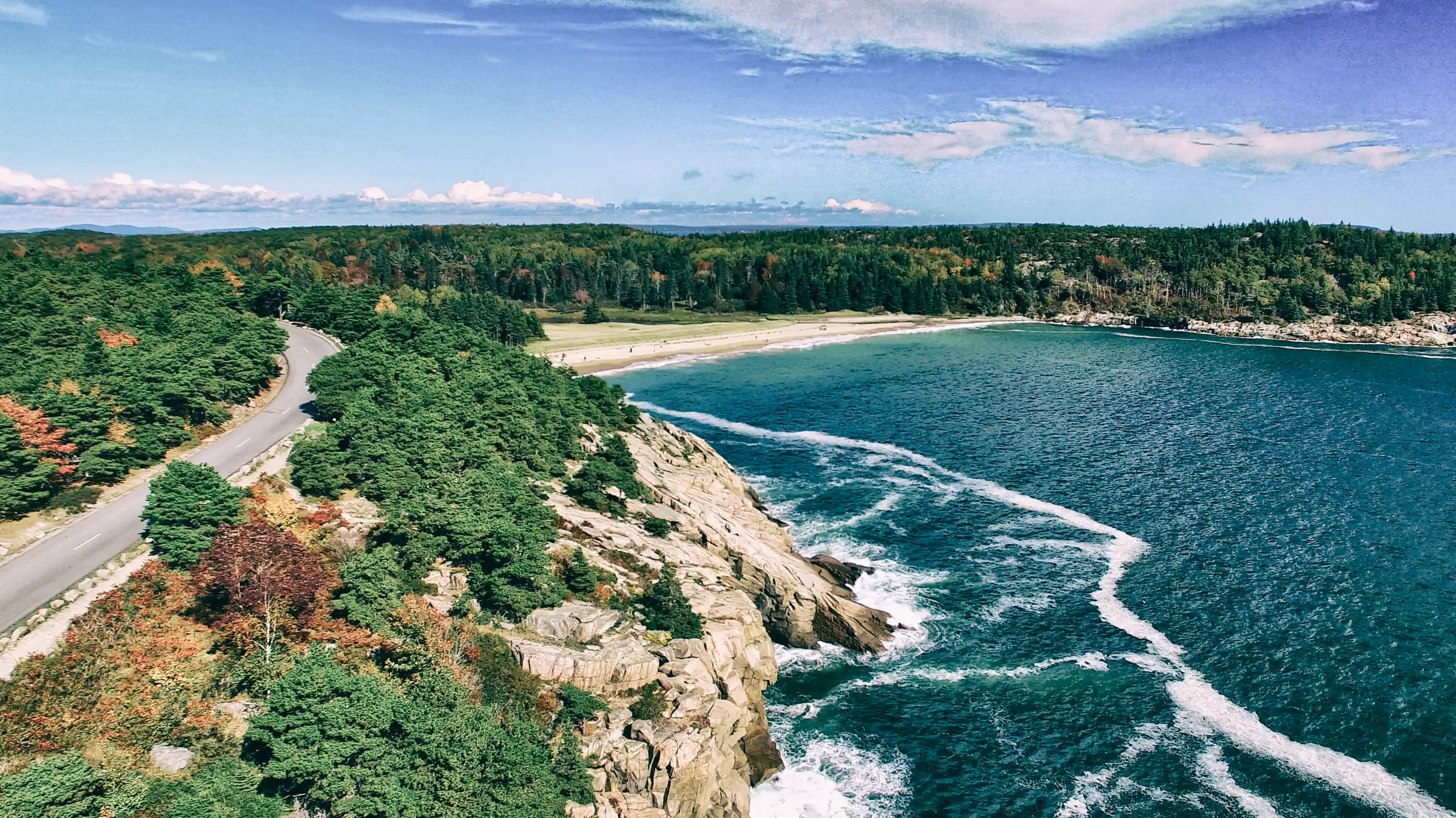
You may need a vehicle reservation. Acadia ranks among the top-ten most visited national parks, yet it’s also among the smallest and most congested. Beginning this summer, the National Park Service is requiring to drive on the Cadillac Summit Road during daylight hours, including sunrise, when thousands flock to the East Coast’s highest point (1,529 feet) to watch the day’s first rays spill over Frenchman Bay. (For part of the year, Cadillac is also the first place in the U.S. to see the sunrise.)��The future promises similar plans to manage traffic along the��two-mile stretch of Ocean Drive that is home to��the Jordan Pond House restaurant, where people craving an airy popover with strawberry jam and a view of the Bubbles mountain peaks��circle endlessly looking for a parking space.
The Island Explorer will be your lifeline. This�� is the best way to avoid the frustrating search for parking at popular destinations like Cadillac Mountain, Jordan Pond House, Sand Beach, and Thunder Hole. Island Explorer��operates all day and into the night from mid-June to mid-October. Ten routes link village centers, hotels, and campgrounds with points in Acadia’s MDI and Schoodic districts. I use it to solo-hike one of my favorite routes—the wide-open granite spines of Champlain and Gorham Mountains (park at the Tarn on Route 3, ascend via Beachcroft Path, and follow the Champlain South Ridge and Gorham Mountain Trails to Monument Cove on Park Loop Road, then catch the bus at Sand Beach for a ride back to your car).
You can bring your pup. Acadia is one of very few national parks that allows dogs, as long as they are leashed at all times. Along with trails and carriage roads, pets are permitted at the Blackwoods, Seawall, and Schoodic Woods campgrounds. The exception is Duck Harbor on Isle au Haut, though dogs are allowed on day hikes on that��island.
There’s more to Acadia than MDI. Without a doubt, you get the biggest bang for your buck in Acadia’s MDI section, with its extensive coastline, 100 miles of hiking trails, and 45 miles of car-free carriage roads. But Acadia’s other two districts, on the Schoodic Peninsula and Isle au Haut, are every bit as beautiful. Just a fraction of the park’s 3.4 million annual visitors make the hour’s drive from Bar Harbor to 2,266-acre , on the east side of Frenchman Bay. There are no mountains here and no soaring cliffs. Rather, Schoodic soothes with slow pleasures. A six-mile one-way loop road hugs the peninsula’s pink-granite shoreline, with plenty of turnouts to stop and watch lobster boats in the bay and to clamor over��the wave-beaten headland at Schoodic Point. The lightly trafficked, mostly flat road makes for a terrific leisurely bike ride. Get your heart pumping on the eight miles of gravel bike trails that wind through the forest of pine and spruce trees draped with gray-green bearded lichen. Most of the 7.5 miles of hiking trails are short, but all are rewarding, and it’s easy to cobble together longer hikes. Several paths lead to Schoodic Head, the peninsula’s highest point at 440 feet.
Visiting , 15 miles southwest of MDI, takes extra��planning, but it’s worth it. Slightly more than half of the 8,000-acre island is privately owned and part of the lobstering town of Isle au Haut (with a year-round population of��50). The rest belongs to Acadia��and receives 6,000 to 7,000 visitors annually. Eighteen miles of rugged, mostly oceanside��trails are the draw. If you have time for just one hike, make it the 3.7-mile Western Head loop, which��dips and rises across rocky beaches and cliffs. There are no motels and inns on Isle au Haut, only rental homes and five primitive campsites within the park’s perimeter. Likewise, there’s no car ferry and no paved roads. In summer, the local mail boat makes daily round-trips from the coastal town of Stonington to Isle au Haut’s town landing and to Duck Harbor, near the campground and trailheads.
How to Get There
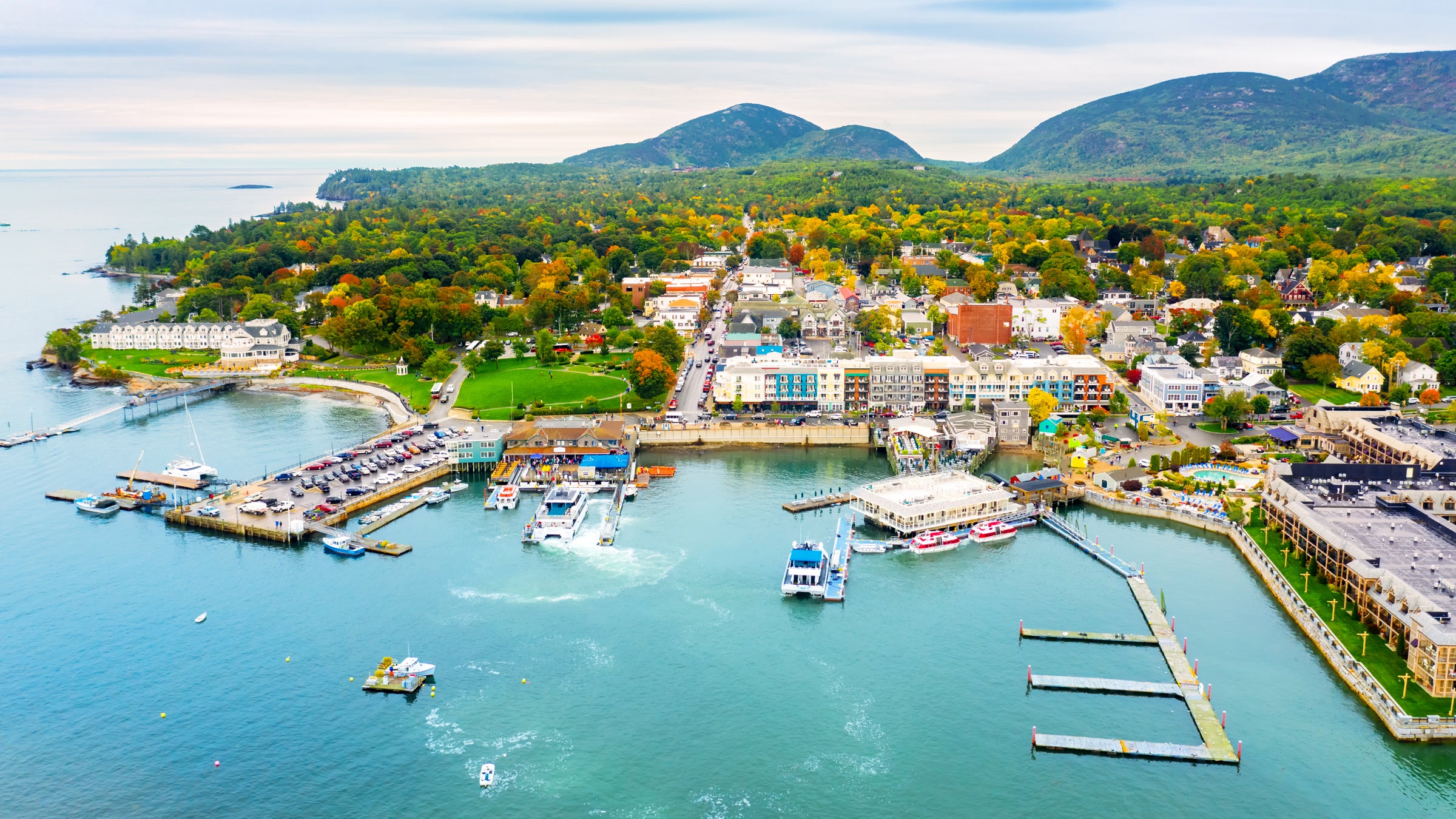
Acadia is the��only national park east of the Mississippi River and within a day’s drive of nearly one-quarter of the U.S. population. Most��visitors head��up Interstate 95 to Bangor, Maine, then southeast on Route 1A to MDI. Access Park Loop Road via one of five main entrances: at��, off��Route 3 north of Bar Harbor; , off��Route 3 south of Bar Harbor; Sand Beach Entrance Station, on Schooner Head Road, which will ; Stanley Brook, on Route 3 in Seal Harbor; and Eagle Lake Road, on Route 233. The closest major airport is Bangor International, an hour north, but more airlines serve Portland International Jetport, three hours south. The Cat, Bay Ferries Limited’s high-speed ferry, travels between Bar Harbor and Yarmouth, Nova Scotia, but service in 2021 hinges on pandemic-related travel restrictions.
The Best Time of Year to Visit Acadia National Park
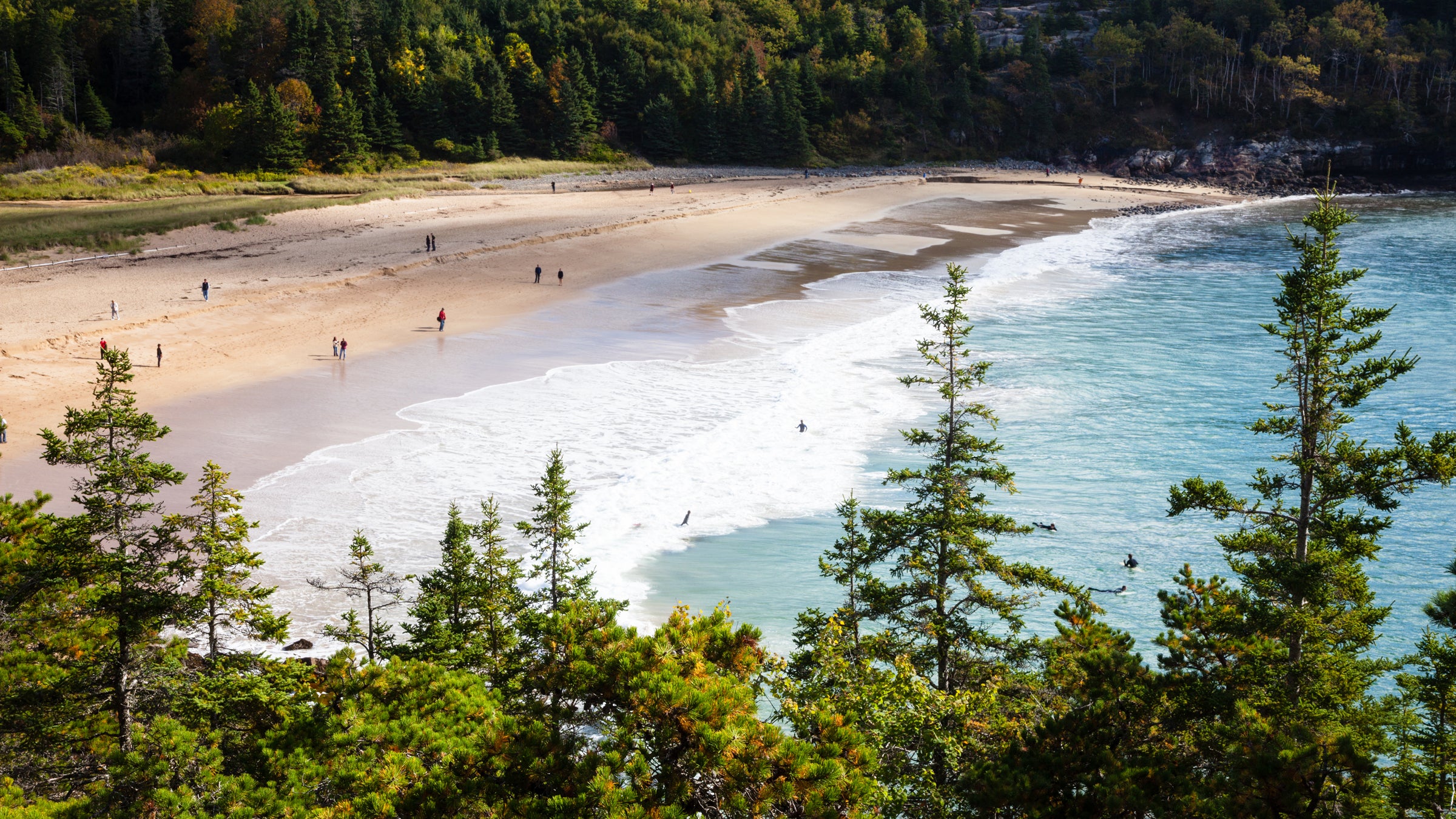
Winter
Acadia is nearly deserted from December to March, when temperatures range from 15 to 40 degrees. The average snowfall is 60 inches, but��the amount the area actually sees��each year��varies. Coastal storms often throw in some freezing drizzle or sleet. A good snowfall, however, turns Acadia’s carriage roads into ideal cross-country-skiing tracks. Only a smattering of hotels are open year-round. Check out the (from $109), a large complex on Frenchman Bay with a fitness center, and the cozier (from $89), a renovated 19th-century sea captain’s house in Bar Harbor.
Spring
April is often windy and muddy in Maine, but May and June are lambs. Daytime temperatures on MDI are typically in the mid-sixties��to mid-seventies—great for hiking and biking—and the crowds have yet to arrive. Biting blackflies are a downside, so stock up on bug juice. In Bar Harbor, most hotels, inns, and restaurants open by Memorial Day weekend.
Summer
I’ve grumbled enough about the July and August congestion, so here’s the good news: the hordes��mostly converge at a few Park Loop Road attractions and are easy to avoid. Solitude can be found simply by stepping onto a hiking trail or carriage road. Tourist magnets like Sand Beach and Thunder Hole are well worth seeing, but you’ll enjoy them more if you go before 10 A.M. Likewise, skip the noontime zoo at Jordan Pond House and get your tea and popovers in the late afternoon. It rarely gets unbearably hot on the Maine coast. Summer temperatures hover in the high seventies. Evenings can be cool, averaging the mid-fifties, so pack accordingly. Fog may roll in off the ocean and settle thickly on shore for days at a time. Think of it as Maine giving you a hug.
Fall
Glory days. The first half of September in Acadia is summer without the bugs, humidity, and fog—just lots of sun and clear blue skies, with temperatures in the low seventies. The excellent, though cooler, weather continues for several weeks as the foliage turns crimson, gold, and orange, reaching its peak in early to mid-October. The fiery colors are mirrored in the waters of Eagle Lake, Long Pond, and Jordan Pond��and are best experienced by kayak. See the show from a lobsterman’s perspective on a Sea Princess ranger-narrated cruise out of Northeast Harbor. Maine’s weekly keeps tabs on the changing colors statewide.
Where to Stay in and Around the Park��
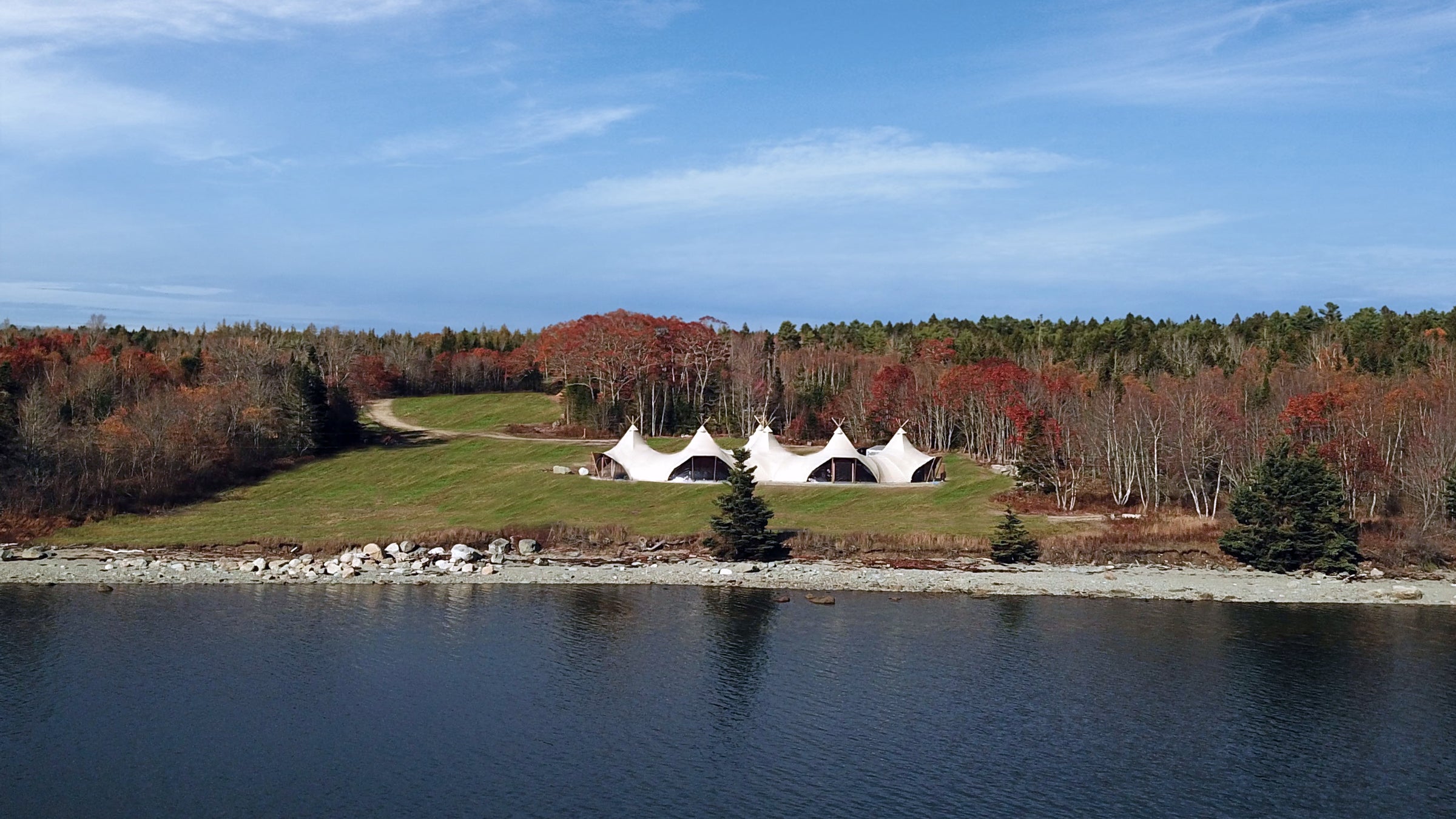
Four , open spring through fall, provide the only overnight accommodations within the park. On MDI, the�� and campgrounds feature��a total of 483 sites��for primitive, drive-up, and group tenting and unserviced RV camping (from $22). Acadia’s newest campground, , has spiffy amenities like a 100-seat amphitheater and the widest range of camping options, including RV sites with electricity and water (from $22). on Isle au Haut has five lean-to shelters ($20); advance reservations are a must. None of the campgrounds have showers, but pay showers are available just outside Blackwoods and Seawall and at the on the peninsula.
There’s no shortage of private campgrounds, hotels, and inns on and around MDI. Set to open in May is glamping operator Under Canvas’s , which will offer��100 safari-style tents amid��100 acres of coastline,��just a 35-minute drive to the park (from $314). New as of 2020 is , KOA’s first luxury-camping venture, with five styles of furnished tents (from $218) and a glass-walled lodge serving meals and signature cocktails. I’m a sucker for MDI’s many vintage, family-owned cottage courts, such as (from $92). On the Schoodic Peninsula, sits across from Sand Cove on its own 200-acre nature preserve laced with trails (from $150). Owners Ben and Sonja Walter-Sundaram have renovated the property’s barn for concerts and a lecture series focusing on local and Maine history and the natural sciences.
What to Do While You’re There��

Hiking
The is an exhilarating 0.9-mile ascent of the sheer��1,000-foot cliff face on the east side of Champlain Mountain. The ascent��switches back and forth��via narrow stone stairways, iron rungs, and one-foot-wide ledges, with nothing but a length of rebar between you and the drop-off. The views of Frenchman Bay are breathtaking—if you dare to take your eye off the path. Descend via the steep (but not very scary) Orange and Black Trail. The Precipice is usually closed part of each summer to protect nesting peregrine falcon chicks. If you’re not sure you can handle this trail, how about a trial run on the smaller Beehive? This path��heads to the top of the 520-foot-high dome, which overlooks��Sand Beach and also features a near vertical climb with narrow ledges and rungs embedded in the rock face.
Thank (or curse) the aforementioned preservationist George Dorr for the Ladder Trail, which heads up��the steep east face of 1,265-foot Dorr Mountain. The half-mile trail is almost entirely a stone staircase, with a few iron rungs embedded in granite. The descent is a��gentle one��via the��via the South Ridge and Canon Brook Trails, which afford��ocean views much of the way. This workout is a��3.5-mile round-trip.
On the west side of MDI (a.k.a. “the quiet side”), the popular 3.9-mile loop linking 681-foot Acadia and 679-foot St. Sauveur Mountains has several steep sections and some fun rock scrambling. Make the most of the vista��of Somes Sound, the East Coast’s only “fjard” (a sort of junior fjord), by extending your hike from Valley Cove to 284-foot Flying Mountain,��summiting St. Sauveur on your return: take the Valley Cove Trail to Flying Mountain,��loop back on the Valley Peak Trail, and��follow the St. Sauveur Trail and Man O’ War Brook fire road back to the Acadia Mountain Trailhead on Route 102, a total of 6.5 miles.
The 1.3-mile Ship Harbor Nature Trail or the 1.4-mile Wonderland Trail��in Bass Harbor are easy and ideal for families with young children. Both lead to rocky shorelines with lots of tide pools to explore.
Biking
John D. Rockefeller Jr. built Acadia’s carriage roads so he’d have a car-free place for his horse-drawn carriages. They also happen to be perfect for road biking, with routes that follow the contours of the land and take full advantage of magnificent views.
Advanced cyclists will like the 11-mile carriage road, which circles Parkman, Sargent, and Penobscot Mountains, climbing steadily to 700 feet. Your effort is rewarded with fantastic lookouts��of Jordan Pond, Somes Sound, and the Atlantic, not to mention a long and wicked-fun descent. By the time you’re done, you’ll have crossed six of Rockefeller’s 17 carriage-road bridges, each one unique and faced with quarried island granite.
The six-mile Eagle Lake loop is Acadia’s most popular carriage road, with a couple of long, gradual ascents and descents and some relatively flat stretches. This is a good one for families with children.
I like to combine the Witch Hole Pond and Paradise Hill carriage roads for a 4.6-mile loop ride. I start at the and head��south, making my way past a chain of placid ponds and marshlands, then turn northeast toward Duck Brook (in late July, I stop to pick wild blueberries that grow along this stretch). I take a break at , not because I need it—this is an easy ride—but because the bridge, with its three high arches and turreted viewing platforms, is beautiful. Then it’s on to Paradise Hill, with panoramas��of Hulls Cove and Frenchman Bay, and back the visitor��center.
Paddling
Ragged with small coves, harbors, and��beaches, MDI’s coast invites exploration by boat. There are plenty of rental shops in Bar Harbor. Be aware that the ocean here is cold—less than 55 degrees in summer. A wetsuit is recommended.
Somes Sound��nearly splits MDI in two and��stretches��five miles��from the Narrows, a quarter-mile-wide channel between the villages of Southwest Harbor and Northeast Harbor, to Somesville (all three villages are part of the town of Mount Desert Island). With Norumbega Mountain on the east shore and Acadia and St. Sauveur Mountains on the west, the paddling here is fairly protected, and the scenery is lovely. Northeast Harbor and Southwest Harbor both have boat ramps at the sound’s mouth, but time your trip carefully—an outgoing tide will test your strength. You also can launch from the Sargent Drive picnic area, about midway up the sound in Northeast Harbor.
Mount Desert Narrows, the channel separating MDI from the mainland, is a leisurely saltwater paddle. Put in at Hadley Point in Bar Harbor and head southwest, passing Thomas Island and the Twinnies (a pair of small islands),��to Thompson Island in Thomas Bay. Return along the other side of Thompson and the Twinnies for a roughly six-mile round-trip. High tide is the best time to paddle here, since Thomason Island is surrounded by mud flats at low tide.
Harbor seals are often spotted on the eight-mile loop around the Porcupine Islands off Bar Harbor in Frenchman Bay. These five small islands, four of which belong to Acadia, offer some shelter for paddlers. Still, this is an open-sea excursion; if you’re not an experienced sea kayaker, go with a guide from one of MDI’s many outfitters. Launch from the Bar Island access road or gravel beach.
For freshwater paddling, it’s hard to beat the scenery at the mile-long Jordan Pond. The image of the small rounded mountains known as the Bubbles at the pond’s north end has been made iconic by thousands of photographers. A footpath rings the pond, making it easy to combine a paddling trip with a hike. Put in at the south end of the pond��near the parking area. After your paddle, stroll over to the Jordan Pond House, where you can soak up the view once more, this time while fortifying yourself on creamy lobster stew and popovers.
Long Pond (a.k.a. Great Pond, to distinguish it from the smaller Long Pond in Seal Harbor) is MDI’s largest inland body of water, stretching nearly four miles. Much of the pond’s narrow southern half is within the park, banked by Mansell and Beech Mountains. You’ll likely see eagles, ducks, loons, and ospreys. Boat launches are found at the pond’s northern and southern ends.
Rock Climbing
With nearly 300 single- and multi-pitch routes, Acadia National Park offers a variety of mostly traditional climbs on small pink-granite cliffs. Many routes have fixed rappel stations. Several outfitters offer instruction, including Bar Harbor–based and .
Best known as the thrilling climax of a Park Loop Road scenic drive, Otter Cliff is by far the most used climbing destination. With waves crashing below them, climbers enjoy spectacular views of Sand Beach and the sea stacks at Monument Cove. Seventy routes ranging from 5.3 to 5.13, are set on the steep 60-foot cliff, which is broken up by horizontal cracks. NPS maintains some fixed anchors here; using trees is forbidden. More ocean climbing can be found at Great Head, on the east end of Sand Beach, where 37 routes range from 5.6 to 5.13b. At both sea cliffs, use extra caution at high tide and when the surf is high — waves have swept people into the sea from the base of Otter Cliff, and one climber drowned at Great Head after becoming stranded in a sea cave.
The Precipice, on Champlain Mountain’s south wall, has about 80 routes ranging in difficulty from a 5.4 to 5.12b, many with multiple pitches, thin cracks, and good corners. The upper wall looks out over Frenchman Bay, the Porcupine Islands, Egg Rock Lighthouse, and the Schoodic Peninsula.
South Bubble Mountain, overlooking Jordan Pond, is a good beginners’ destination with mostly low-angle climbing on the lower wall. Climbs on the upper slab and wall are more challenging. Routes on South Bubble are graded 5.3 to 5.10b.
Sailing
From day trips to private rentals, there are plenty of options to take in the park’s shoreline from a sailboat. Check out the outfitters��in the surrounding communities, and have your pick of anything from classic sloops to lobster��boats.
Nordic Skiing��
The all-volunteer grooms more than 30 miles of carriage roads, including 3.5 miles ideal for novices along Eagle Lake’s western shore and the hilly and twisty Aunt Betty’s Pond loop. You can even ski on Park Loop Road, portions of which are unplowed. Among these is the left lane of spectacular Ocean Drive between Schooner Head and Otter Cliff Roads (it’s open to snowmobilers, but I’ve never encountered any).
Stargazing
On summer nights, hundreds of Acadia visitors stretch out their blankets on Sand Beach to lie back and gaze at the stars while park rangers point out planets and satellites and tell the stories behind the constellations’ names. The program, called , celebrates the largest expanse of naturally dark sky east of the Mississippi, accomplished through a National Park Service policy to preserve natural lightscapes and a Bar Harbor town ordinance that requires new construction projects to install shields on exterior lights so their light is cast downward. Canceled in 2020 due to the pandemic, Acadia’s annual is scheduled to resume in September 2021. A highlight of the five-day event is the Cadillac Mountain Star Party, with rangers and astronomers acting as travel guides to the sky.
Birding
Acadia isn’t well-known as a wildlife-watching destination, save��one exception: birds. More than 300 species spend at least part of the year at Acadia, an important migratory bird stopover and nesting site. Hence the three-day , held annually in early June. Events include guided walks, boat tours, and talks. On your own, look for shorebirds on the mudflats around Thompson Island and Isle au Haut. Prime spots for songbirds include the carriage roads, Sieur de Monts Spring, and Jordan Pond. Nesting falcons can be spotted at the Precipice from mid-April to mid-August. Migrating raptors are all but guaranteed to be soaring over Cadillac Mountain from mid-August to mid-October. Visitors are welcome to join Cadillac Mountain Hawk Watch volunteers, who gather at the head of the North Ridge Trail to count, identify, and record each raptor they see.
The Best Places to Eat and Drink at Acadia National Park��
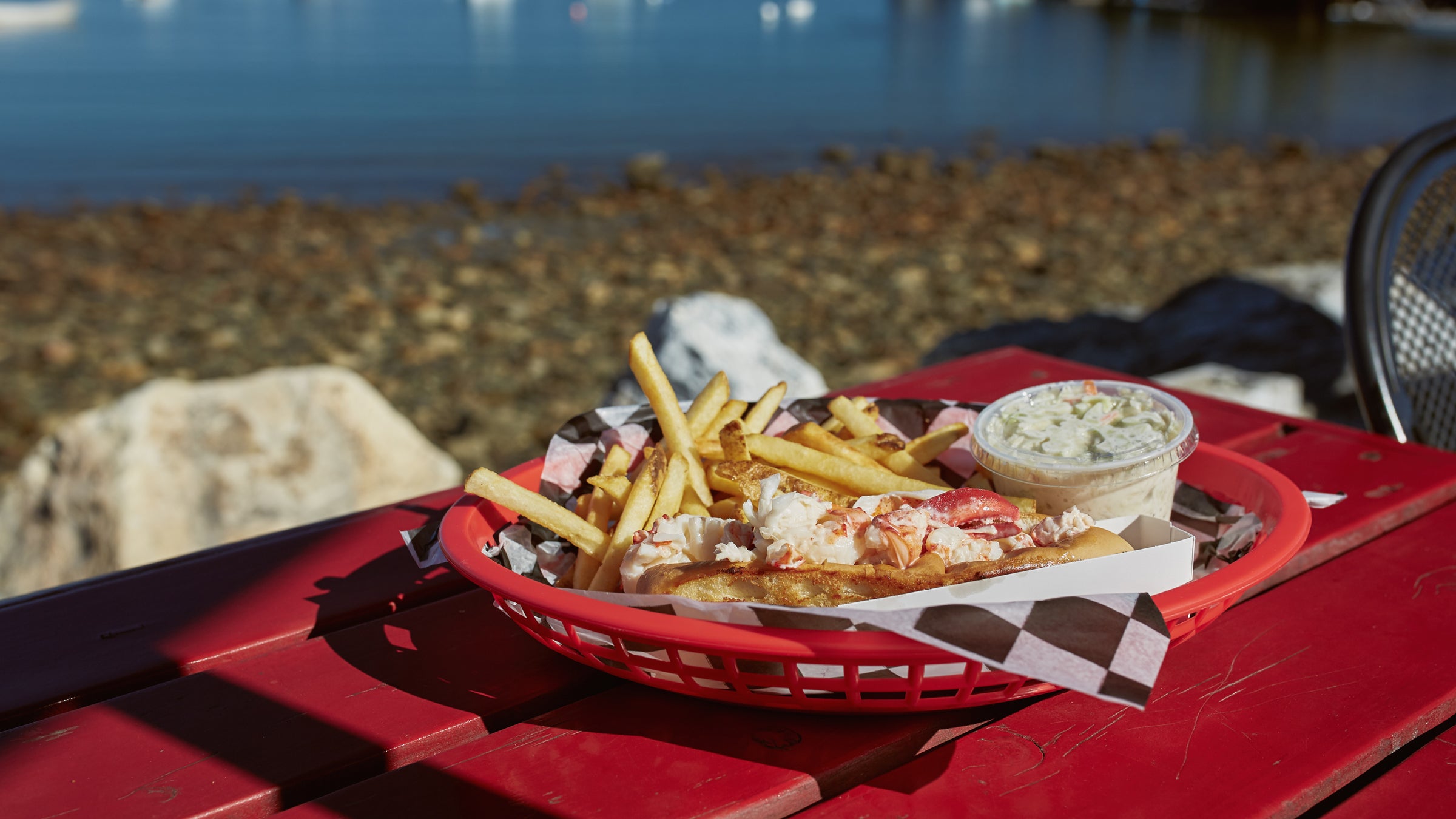
The question is not “Where can we get lobster?” because boiled or steamed lobster, served with drawn butter and corn on the cob, is available everywhere on MDI. What you want is to eat lobster at a place with a great view. The screened-porch dining room at , in the town of Bernard, stretches over Bass Harbor, where boats are arriving with the day’s lobster dinners. , with indoor and outdoor dining, occupies a stunning spot at the head of Somes Sound in the town of Mount Desert. , on the Little Cranberry Island wharf, involves a trip aboard the Beal and Bunker ferry or a water taxi.
The best lobster rolls (also with a side order of views) are found at , located on Southwest Harbor’s working waterfront,��and , set among docks piled high with lobster traps in the tiny fishing village of Corea on the Schoodic Peninsula. For fine dining (without a view), , in downtown Bar Harbor, prepares Caribbean- and Latin-influenced meals with locally sourced meats, fish, and veggies. And yes, Havana serves lobster, but in unconventional ways, like moqueca, a Brazilian stew with coconut broth and rice, and paella,��with other goodies like mussels, shrimp, scallops, chorizo, and smoked chicken. For sips, try the Cuba libre, made with Gosling’s Gold rum and Mexican Coke. Feast on heaping plates of slow-smoked pulled pork, sausages, ribs, and chicken in the charming courtyard of ’s Town Hill location. Wash it down with the brewery’s signature Bar Harbor Real Ale.
If You Have Time for a Detour
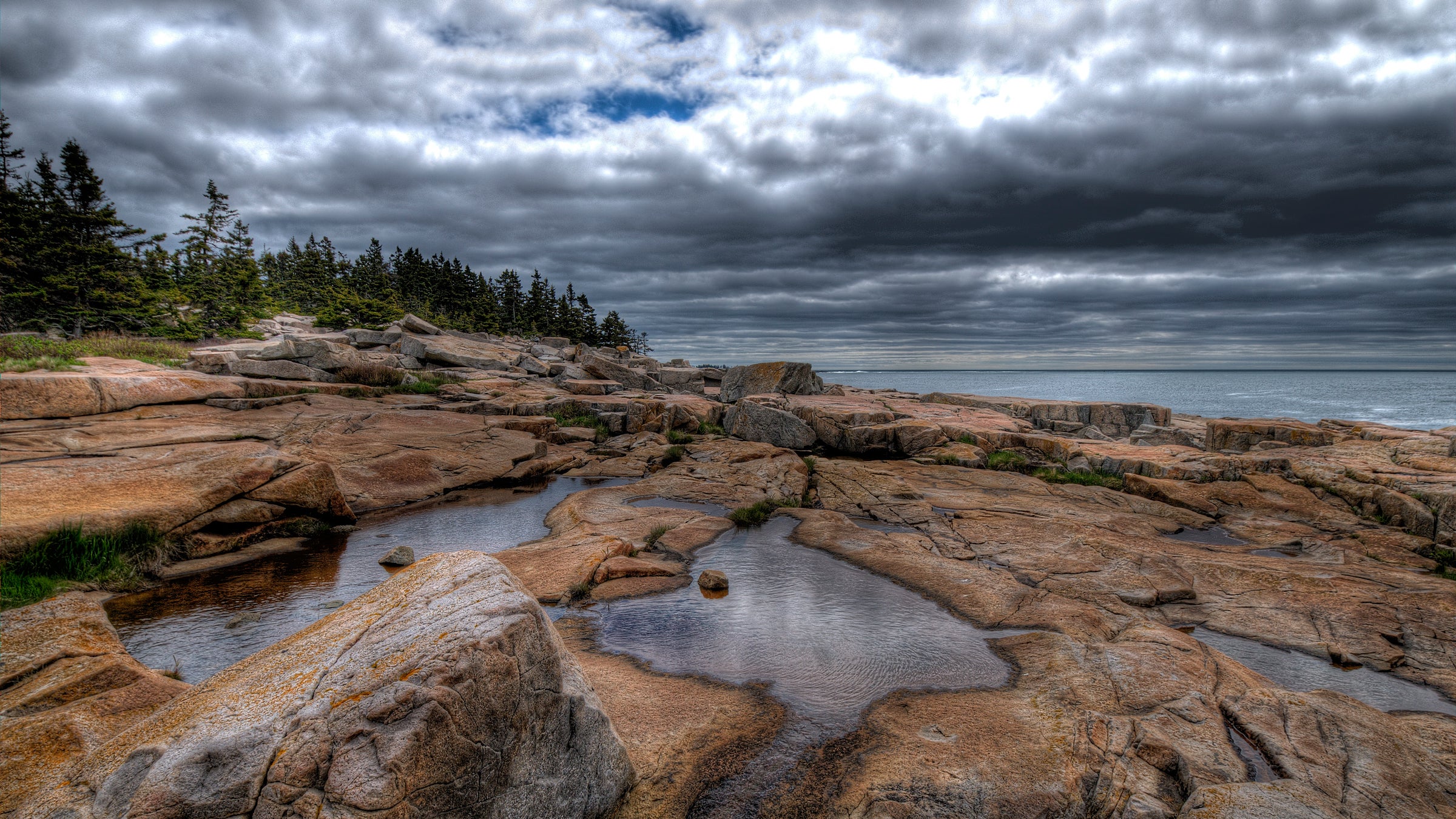
Load up your kayak and head inland to the , a 14,000-acre forested reserve about an hour’s drive north of��Bar Harbor. Pristine Donnell Pond, which covers��1,138 acres��and has��15 miles of shoreline, can easily occupy paddlers for the better part of day. Fishing��is good for landlocked salmon, lake trout, white perch, and smallmouth bass. Loons, eagles, and ospreys fish here, too, which makes for good bird-watching. Primitive campsites, reachable only by water or hiking trails, can be found at Redman’s Beach on the pond’s east side and Schoodic Beach on the pond’s south end. Pick up the trailhead for 1,157-foot Tunk Mountain at the parking lot off Route 182��between the towns of Franklin and Cherryfield. From Tunk’s summit, you can see the lake-dotted forest stretching to the north, as well as Mount Desert Island and Frenchman Bay to the southwest. Total mileage, with a loop around Salmon Pond to the shore of Little Long Pond, is 4.4 miles.
How to Be a Conscious Visitor��

You just emerged from the trees, and a panorama—ocean, lakes, forest—is revealing itself as you scramble up a granite outcropping toward the mountain summit. In your exhilaration, you grab a stone and drop it on the nearest cairn as if to say,��I was here! Please don’t do that. Acadia National Park has a unique stone trail marker—the Bates cairn, named for Waldron Bates, who, like George Dorr, specialized in path making on MDI in the early 20th century. A Bates cairn consists of four rocks: two large base stones laid roughly a foot apart and��topped by a flat rock, on top of which sits a fourth rock pointed in the direction of the trail. Some of the park’s cairns are originals, more than 100 years old. Excessive cairn-building, whether adding to existing cairns or creating new ones, not only mucks with that history��but also confuses hikers trying to follow a trail, contributes to soil erosion, and detracts from nature’s beauty. It’s such a nuisance that has a crew of volunteer ridge runners whose mission is dismantling outlaw cairns and educating hikers to leave no trace.��Resist the urge to build your personal memorial, and take a selfie instead.
